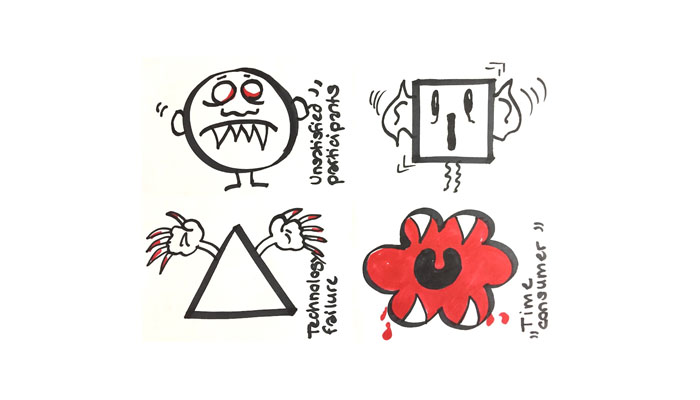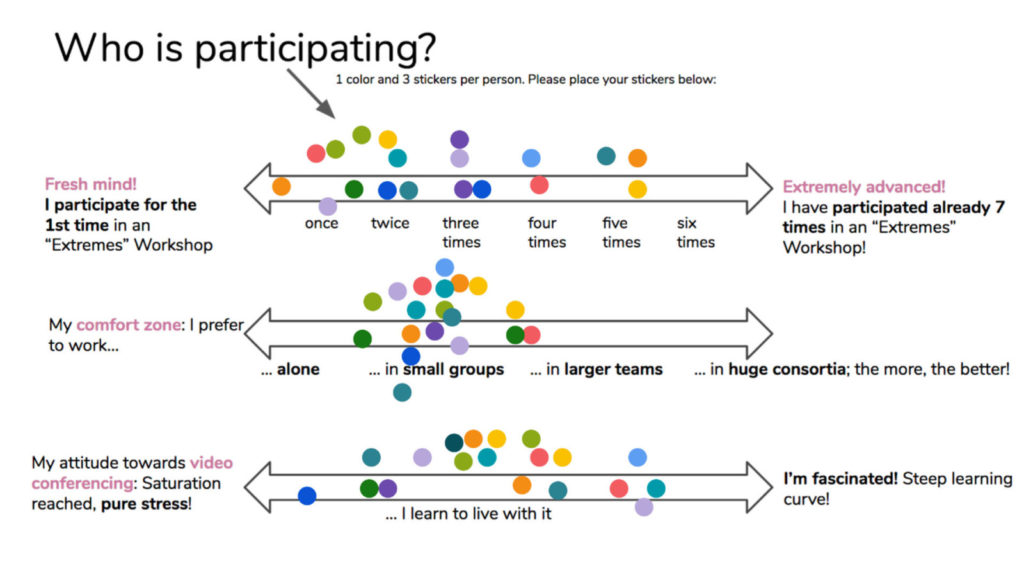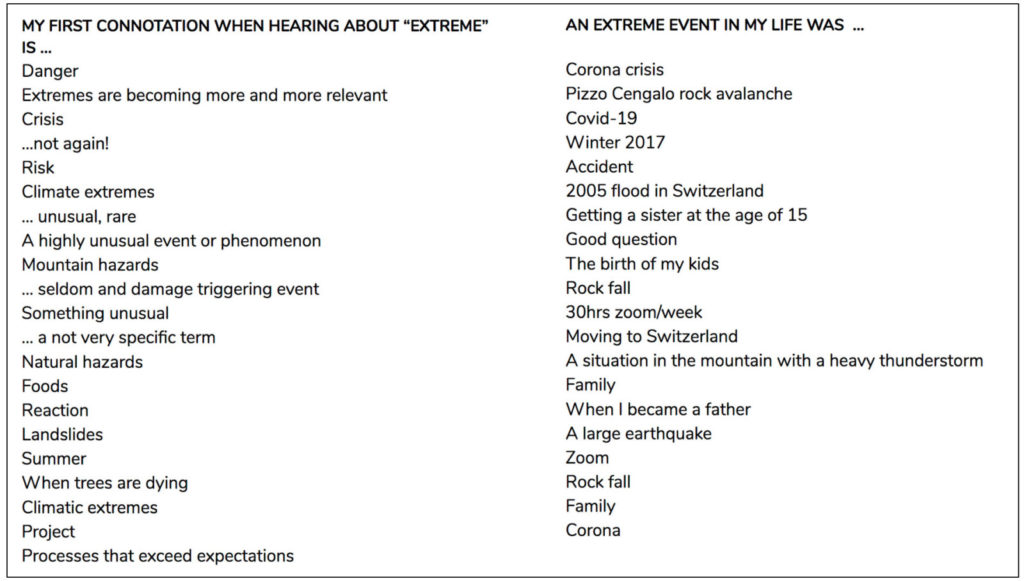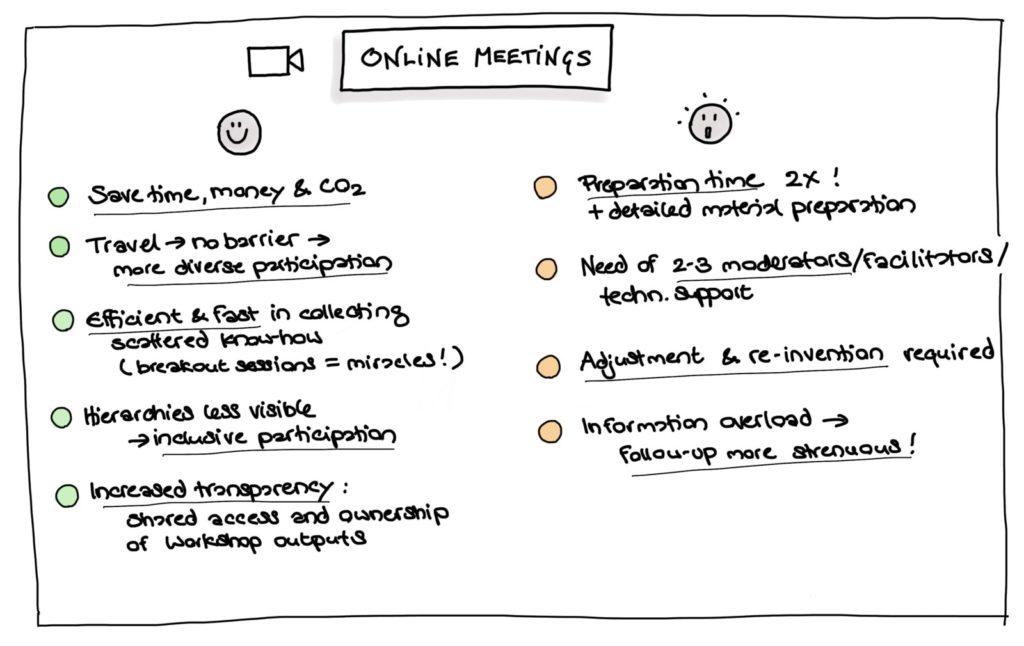
Some people claim that teaching online courses or virtual workshops is not very different from face-to-face meetings. In my experience, however, it is much harder to sneak away secretly from a half-occupied seminar room than to withdraw from a virtual meeting where you simply mute the speaker to work on your emails located only one mouse click away. And that’s not all! In contrast to physically present listeners, participants of online meetings are stingier with their time, more easily distracted and probably fed up with sitting petrified in front of their monitors, mentally floating like sedated satellites. While for some people the anonymity of the home office is comforting, others feel isolated, invisible and unheard. Obviously, there are many reasons why facilitators of virtual meetings need to rethink their habits, tricks and tools!
I am a fan of face-to-face meetings. In early March 2020, however, Covid-19 deprived me – like many others – of my cherished moderation tools, colorful flipchart feasts and tangible instant products. But I was extremely lucky to benefit from a timely training course; “Bringing meetings online” offered by Corinne Sprecher and Nadia von Holzen. Since then, I have had ample opportunities to fully exploit my newly-learned online tools. I discovered: Virtual meetings can be highly stimulating and fun!
Below, I share the “secrets” about how to make online workshops and courses effective and stimulating. The bottom line is that they must be simple, inclusive and fast, yet unhurried and funny!

1 Simple
Let us face the fact: Most of us are tired or simply overwhelmed by the multitude of video conferencing tools and software. Me too. Multi-tasking is a challenge for slow minds like mine. That is why I reduced the tools to Zoom and Google Slide Deck (here is an example – edit it, but please leave it in tact for the next visitor!).
As for Zoom, I recommend a license granting access to undisturbed meetings with manifold options such as organizing polls, breakout sessions or recording. One of my favorite gadgets is the chat box. Zoom is a convenient tool for oral and visual communication.
The Google Slide Deck is an online Powerpoint presentation accessible to everyone without any registrations or logins needed (though you as the owner must have an account). Prior to the meeting, send the link to participants and ask them to open the browser window. The Slide Deck guides everybody through the event and documents the inputs. Participants can navigate freely through your input presentation and other slides. This is different from the “Screen share” mode in Zoom, which incapacitates the presenter, demoting everyone else to passive viewers. On the Slide Deck, all attendees can re-read instructions and document results from the breakout sessions themselves. Thereby, they maintain control and can continually read, comment and edit all products. That is why I really love it!

2 Inclusive
Engaging your audience making them part of the process is the key for ensuring their attention. You can invite participants to join 15 minutes before the official opening for an informal chat, to test the tools or for a joint visualization of “Who is participating?” (Google Slide Deck, Figure 1).

Fig. 1: By addressing three questions prior to the virtual meeting, participants get a first sense of “Who’s who” and can try out the joint documentation tool on the Google Slide Deck.
My favorite alternative to lulling introduction rounds is the Mad Tea Party. This exercise takes less than 5 minutes. First, you ask everybody to open the Zoom chat box. Then you post a question or a first part of a sentence IN CAPITAL LETTERS (easier to detect in a full chat box). It can be something serious related to the workshop (e.g. here a connotation on “Extremes”) or something more private (e.g. an “extreme” event in my life). Participants then write their spontaneous answers in the chat box and wait for the signal “Go!” before they publish their results. Then, you post the next question or sentence. Repeat this exercise 4-5 times and allow participants to go through the answers (Figure 2). This is an effective tool to attract everyone’s attention and to focus on the workshop topic.

Fig. 2: Answers collected in a “Mad Tea Party”. This was an ice-breaker of a workshop, which aimed at the development of a new research program on “Extremes”.

3 Fast
As a matter of fact, the time saved for not traveling to or from a conference is not automatically credited to the workshop’s time budget! In contrary, participants of virtual meetings tend to drop in rather unprepared and on the fly. Upon closing, they often switch directly to the next meeting. All in all, Covid-19 has accelerated the academic carousel depriving us of long train rides to prepare or think through future or past events. In an online world, keeping up with the speed while creating temporary retreat places for reflections is a serious challenge.
This has several profound consequences. Online meetings should be limited to maximum 2-3 hours. Conferences originally scheduled for several days could be chopped in smaller pieces if conducted online; they could even be replaced by a series of shorter sessions spread over several weeks with other forms of interaction in between. The shift from analogue to digital offers immense space for re-thinking conventional conference settings! In the same vein, lengthy monologues should be kept to a minimum or be replaced by webinars or videos recorded and viewed in advance.

4 Unhurried
Given the high speed and intensity of online meetings, the organizers must make sure to plan sufficient silent/individual work and breaks. It is recommended to have 5-10 minute breaks every 30-40 minutes, but this depends on the meeting’s flow and format. We are often tempted to skip the coffee break in online meetings, although in an analogue world, such informal breaks are important networking opportunities. As many of us are rather inhibited for small talk in large online crowds, it is recommended to allow people to break up into smaller groups during the coffee break. This can be done by making all participants “co-moderators”, allowing them to meet with people of their choice in smaller breakout rooms. The same is true for the cozy toasting after the meeting: Keeping the Zoom meeting open for 15-30 minutes after the official end will allow participants to get back with each other informally – with or without a beer or coffee.

5 Funny
Creativity needs comfort. Comfort in turn depends on mutual trust and respect. There are plenty of ice-breaker tools that help us share our passions, motivations and fears. They can be used throughout the workshop for a quick recovery after intense work session. A favorite of mine for closing an exhausting session is a drawing exercise. Prior to the workshop I ask participants to have a sheet of paper and a thick marker ready. Then, I invite them to make a quick drawing of the main workshop results or a visualization of a particular term (e.g. “Extremes” for our last workshop). After 1-2 minutes, everybody shows the sketch for a joint Zoom Screen Shot (Slide 23 in the Google Slide Deck). This is fun but also reminds us that we can still include real world items and rituals in a virtual meeting! For my own example, see the illustration at the top of this blog.
In summary, my take home messages about online meetings are (Fig. 3):

Fig. 3: Summary of recommendations for online meetings
A final confession on my part: When the Covid-19 wave subsided in Summer 2020 allowing us to organize face-to-face meetings again, I was shocked and definitely embarrassed to detect a cheeky thought of mine. I found myself thinking: “Oh no, I would rather have a Zoom meeting! How I am going to deal with real people again?”

By Guest Blogger Astrid Björnsen Gurung
Astrid Björnsen Gurung is (Co-)Coordinator of two Research Programs: ‘Energy Change Impact’ and ‘Extremes’ at the Swiss Federal Research Institute WSL (Switzerland). Apart from her scientific interests related to water, renewable energies and mountains, she fosters a passion for knowledge sharing and integration to enhance the societal relevance of research.
Edited by Bettina Schaefli

Dominique Wirz
Thank you for this comprehensive overview and guide about online meetings. Nice inputs to be tried out soon!
Astrid Björnsen
Thanks Dominique! I am really convinced that we have to render online meetings more pleasant and productive. It is hard enough to speak in front of a flat screen, let alone if the cameras are switched off leaving you with the feeling that everybody has left (doing yoga in the background, answering emails or hanging the laundry in the cellar)! We really need some new tricks to keep people attentive and to create benefit from online meetings for all! I keep trying too!
Gabriele Müller
Thank you very much Astrid! Your blog is an excellent RE-freshing for me. I attended the same (indeed highly recommended) contiuing education course “Bringing your Meetings and Workshops online” as you mentioned above. And you made a perfect application of all we have learned there. Just great 🙂
Heike Mayer
Very useful. Thanks a lot!